Although we should be educating ourselves year-round, National Indigenous History Month which takes place in Canada in June each year is a reminder to all Canadians to be proactive in learning about the culture and traditions of First Nations, Inuit and Métis and honouring the stories of the Indigenous Peoples who have lived on these lands since time immemorial.
Government of Canada Information – National Indigenous History Month
Picking up a book is one of the best ways for Canadians to gain a deeper understanding of First Nations, Inuit and Métis through their own voices. I have found that reading books by and about Indigenous Peoples has educated me about the history and experiences of First Nations, Inuit and Métis and helped me to better understand the steps that we need to take individually and as a country for reconciliation.
Most of my recommendations are books that I have read in the past five years although a few are books that are on my ‘To Be Read’ list (some even sitting on my bookshelf!). Most are fiction because that’s my reading preference but I have also picked a few interesting and informative non-fiction books for a total of 17 novels and 4 works of non-fiction.
You Might Also Enjoy Reading 21 Must-Read Books Set in Canada
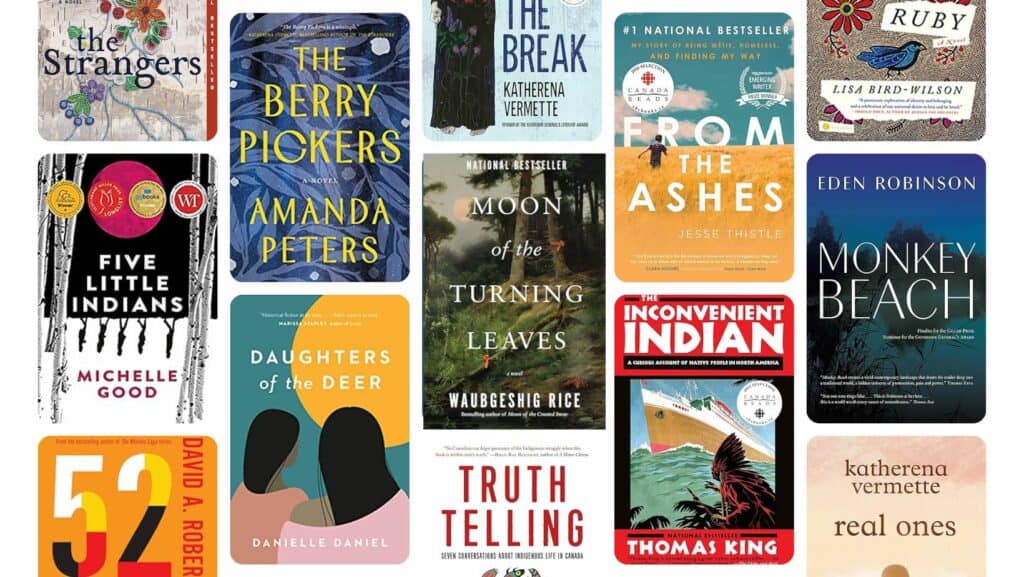
This post may contain affiliate links. If you click an affiliate link and make a purchase then we receive a small commission at no additional cost to you.
We are a participant in the Amazon Services LLC Associates Program, an affiliate advertising program designed to provide a means for us to earn fees by linking to Amazon.com and affiliated sites. As an Amazon affiliate I earn from qualifying purchases.
1. Moon of the Crusted Snow by Waubgeshig Rice

Setting: Remote Northern Ontario
FROM THE PUBLISHER: With winter looming, a small northern Anishinaabe community goes dark. Cut off, people become passive and confused. Panic builds as the food supply dwindles. While the band council and a pocket of community members struggle to maintain order, an unexpected visitor arrives, escaping the crumbling society to the south. Soon after, others follow.
I don’t generally gravitate to post-apocalyptic or dystopian novels but this one set in a small Anishinaabe community in northern Canada appealed to me and I’m glad I read it because it is a fascinating book. It’s a gripping story of survival but I also appreciated the glimpse into the culture of the Anishinaabe people who were pushed from their ancestral lands to live on a reservation in remote Northern Ontario. A short (just over 200 pages) but powerful read!
2. Moon of the Turning Leaves by Waubgeshig Rice
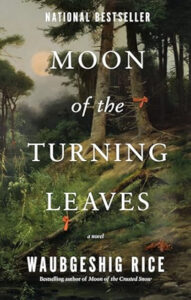
Setting: Remote Northern Ontario
FROM THE PUBLISHER: In this gripping stand-alone literary thriller set in the world of the award-winning post-apocalyptic novel Moon of the Crusted Snow, a scouting party led by Evan Whitesky ventures into unknown and dangerous territory to find a new home for their close-knit Northern Ontario Indigenous community more than a decade after a world-ending blackout.
I have this sequel to Moon of the Crusted Snow sitting on my TBR shelf but haven’t read it yet. It takes place more than a decade later when resources are beginning to run scarce for the new community which has settled in the bush and a scouting party is sent from the settlement on a months-long trip to their traditional home on the north shore of Lake Huron (this is where I grew up so I’m quite interested in seeing it portrayed in the pages of a book!).
3. Daughters of the Deer by Danielle Daniel
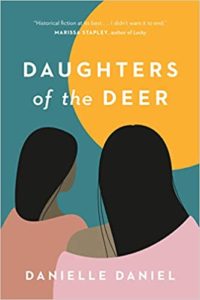
Setting: Near Trois-Rivières
FROM THE PUBLISHER: In this haunting and groundbreaking historical novel, Danielle Daniel imagines the lives of women in the Algonquin territories of the 1600s, a story inspired by her family’s ancestral link to a young girl who was murdered by French settlers.
This is a beautiful, heartbreaking and educational historical fiction novel based on the lives of the author’s ancestors. It’s the story of one mother and daughter but through their story it also highlights the unjust treatment of First Nations people, how the culture and values of the First Nations differed from the French settlers with respect to the environment and to LGBTQ+ people, violence against Indigenous women that continues even today and the evil that was perpetrated by the Catholic church.
A national bestseller in Canada, this is an important and revealing look at Canadian history from a perspective that has been missing from our history books for far too long.
4. The Berry Pickers by Amanda Peters
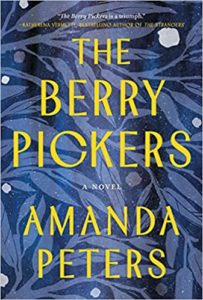
Setting: Nova Scotia and Maine
FROM THE PUBLISHER: A four-year-old Mi’kmaq girl goes missing from the blueberry fields of Maine, sparking a mystery that will haunt the survivors, unravel a family, and remain unsolved for nearly fifty years.
This is a deeply moving story about heartbreak and the lasting impact of trauma but also about family, hope and resilience. I loved this book – the characters are so well-written that I felt that I knew them and my heart broke for them. I wanted so badly to see Ruthie reunited with her family and for them all to find a measure of happiness despite all of the missing years.
The Berry Pickers is a personal story of one family’s hardship but it’s impossible to read without bringing to mind decades of injustice to Indigenous Peoples – residential schools, the tragedy of the ’60s scoop when Indigenous children were taken from their families and adopted into non-Indigenous families, and missing and murdered Indigenous women.
A beautifully-crafted, emotional read – I cried many times while reading and sobbed through the last few pages of the book. Winner of the 2023 Barnes and Noble Discover Prize, it’s hard to believe that this is a debut novel – it’s a story that will stay with me for a long time and well worth reading!
5. Real Ones by katherena vermette
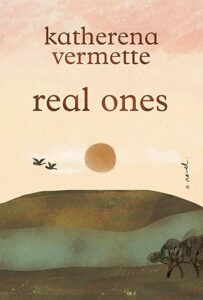
Setting: Winnipeg, Manitoba
FROM THE PUBLISHER: From the author of the nationally bestselling Strangers saga comes a heartrending story of two Michif sisters who must face their past trauma when their mother is called out for false claims to Indigenous identity.
Longlisted for the Giller Prize, Real Ones tackles the issue of “pretendians” who falsely claim Indigenous status for themselves and appropriate Indigenous culture for some benefit – financial or otherwise.
The mother’s actions and the public aftermath is always there in the background but the story is more about the relationship between the two sisters, how they process their own feelings about their mother and their past and how her actions impacted and continue to impact their lives.
Memorable characters and a thought-provoking look at identity and the violence of taking an identity from those who are entitled to it – an excellent and timely read.
6. Waiting for the Long Night Moon by Amanda Peters
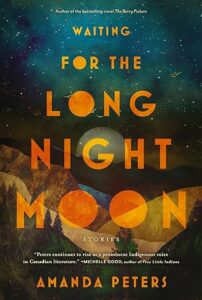
Setting: Various locations
FROM THE PUBLISHER: The stories in Waiting for the Long Night Moon explore the Indigenous experience from an astonishingly wide spectrum in time and place—from contact with the first European settlers, to the forced removal of Indigenous children, to the present-day fight for the right to clean water. Amanda Peters portrays the dignity of traditional Indigenous life, the humiliations of systemic racism, and the resilient power to endure by melding traditional storytelling with her signature style of evocative, spare prose.
An interesting and thought-provoking collection of short stories from the author of The Berry Pickers that educates and provides insight into the Indigenous experience in Canada.
7. In the Upper Country by Kai Thomas
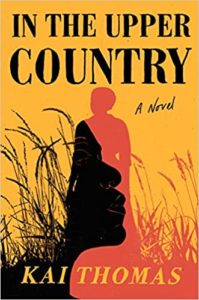
Setting: Canada and the United States
FROM THE PUBLISHER: Traveling along the path of the Underground Railroad from Virginia to Michigan, from the Indigenous nations around the Great Lakes, to the Black refugee communities of Canada, In the Upper Country weaves together unlikely stories of love, survival, and familial upheaval that map the interconnected history of of Black and Indigenous peoples in a wide swath of what is called North America.
Winner of the 2023 Writer’s Trust Atwood Gibson Prize and shortlisted for a number of additional awards including the Governor General’s Award for Fiction, In the Upper Country is a powerful debut novel that uses the stories of two women to show the interconnections between Black history and Indigenous history in North America.
The narrative begins in 1859 in a fictional all-Black town in southwestern Ontario with a fugitive slave who shoots and kills the bounty hunter tracking her. The elderly woman is arrested and a young woman in the community who writes for an abolitionist paper is sent to the jailhouse to get her story. The imprisoned woman agrees to trade a story for a story and so begins a conversation between the two that weaves together tales about slavery, the underground railroad, the War of 1812, and emancipation.
Numerous characters and stories that flow backward and forward in time make it challenging to keep track of the connections at times but it’s worth the effort for the insight into Black and Indigenous history.
8. Probably Ruby by Lisa Bird Wilson
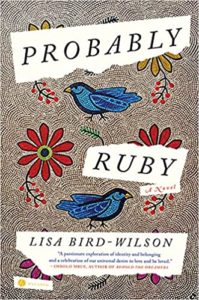
Setting: Saskatchewan
FROM THE PUBLISHER: An Indigenous woman adopted by white parents goes in search of her identity in this unforgettable debut novel about family, race, and history.
Finalist for the Governor General’s Award, Probably Ruby is the raw, heartbreaking story of a Métis woman, adopted into a white family as an infant, who has been struggling all her life to find a sense of belonging. Ruby’s story is told in a series of vignettes that cover decades of her life but aren’t in chronological order – some are from her point of view while some are from the point of view of others who are connected to her at various points in her life.
Ruby’s story is a powerful depiction of the devastating life-long impact that adoption can have on adoptees from an Indigenous background who lose the connection to their cultural heritage.
9. Five Little Indians by Michelle Good
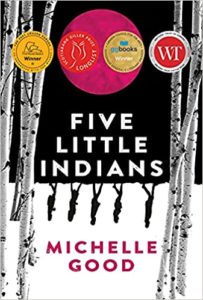
Setting: British Columbia
FROM THE PUBLISHER: Taken from their families when they are very small and sent to a remote, church-run residential school, Kenny, Lucy, Clara, Howie and Maisie are barely out of childhood when they are finally released after years of detention.
Alone and without any skills, support or families, the teens find their way to the seedy and foreign world of Downtown Eastside Vancouver, where they cling together, striving to find a place of safety and belonging in a world that doesn’t want them. The paths of the five friends cross and crisscross over the decades as they struggle to overcome, or at least forget, the trauma they endured during their years at the Mission.
Five Little Indians is a powerful story that portrays the trauma inflicted on First Nations children who were stolen at a young age from their families and placed in residential schools.
Michelle Good’s award-winning debut novel tells the interconnecting stories of five survivors of a residential school in British Columbia who end up in Downtown Eastside Vancouver after their release from The Mission. The novel touches on the physical and sexual abuse that the children endured at the hands of the priests and nuns at the school but the focus is the aftermath of the abuse and how it affects the lives of the five over several decades as they try to overcome the trauma and make lives for themselves in the city.
A story of unimaginable suffering but also a story of strength, resilience and healing and an important read for all Canadians as we come to terms with the legacy of residential schools and the trauma and injustice that Canada inflicted on generations of First Nations children, their families and their communities.
10. River Thieves by Michael Crummey
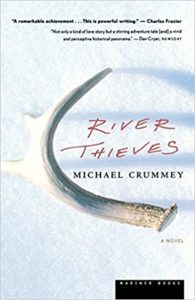
Setting: Newfoundland
FROM THE PUBLISHER: In 1810, David Buchan, a naval officer, arrives in the Bay of Exploits with orders to establish contact with the Beothuk, or “Red Indians,” the aboriginal inhabitants of Newfoundland, who are facing extinction. When Buchan approaches the area’s most influential white settlers, the Peytons, for advice and assistance, he enters a shadowy world of allegiances and old grudges that he can only dimly apprehend.
Years later, when a second expedition to the Beothuk’s winter camp mounted by the Peytons leads to the kidnapping of an Indian woman and the murder of her husband, Buchan returns to investigate. As the officer attempts to uncover what really happened at the Red Indians’ lake, the delicate web of obligation and debt that holds together the Peyton household — and the community of settlers on the northeastern shore — slowly unravels.
Although Michael Crummey isn’t an Indigenous Canadian author, I have included his award-winning debut novel which tells the story of the last Beothuk woman living in Newfoundland. It has been many years since I first read this novel but the powerful story set on the rugged coast of Newfoundland at the turn of the 19th century has stayed with me. The story is richly imagined and Crummey’s writing is evocative but what really struck home was that I knew nothing of the Beothuk people before reading this novel – a failure of our education system to share the stories of Canada’s Indigenous Peoples.
11. Indians on Vacation by Thomas King
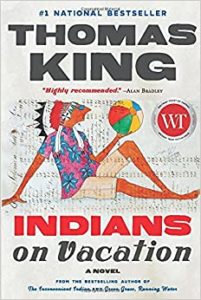
Setting: Europe
FROM THE PUBLISHER: Inspired by a handful of postcards sent nearly a hundred years ago, Bird and Mimi attempt to trace long-lost uncle Leroy and the family medicine bundle he took with him to Europe.
By turns witty, sly and poignant, this is the unforgettable tale of one couple’s holiday in Europe, where their wanderings through its famous capitals reveal a complicated history, both personal and political.
Published in 2020, Indians on Vacation is the first novel that I read by Thomas King who is one of Canada’s most celebrated writers having won awards for both fiction and non-fiction books and who is a recipient of the Order of Canada. King weaves a story about middle-aged Bird and Mimi’s vacation in Prague as well as their lives together in a witty and entertaining way but also touches on serious issues such as residential schools and the refugee crisis in a way that will give you pause.
12. The Break by katherena vermette

Setting: Winnipeg, Manitoba
When Stella, a young Métis mother, looks out her window one evening and spots someone in trouble on the Break — a barren field on an isolated strip of land outside her house — she calls the police to alert them to a possible crime.
In a series of shifting narratives, people who are connected, both directly and indirectly, with the victim tell their personal stories leading up to that fateful night. Lou, a social worker, grapples with the departure of her live-in boyfriend. Cheryl, an artist, mourns the premature death of her sister Rain. Paulina, a single mother, struggles to trust her new partner. Phoenix, a homeless teenager, is released from a youth detention centre. Officer Scott, a Métis policeman, feels caught between two worlds as he patrols the city. Through their various perspectives a larger, more comprehensive story about lives of the residents in Winnipeg’s North End is exposed.
This gritty, heartbreaking debut novel about a multigenerational Métis–Anishnaabe family set in Winnipeg’s north end won the Amazon.ca First Novel Award and was a finalist for the Rogers Writers’ Trust Fiction Prize and the Governor General’s Literary Award. It’s a well-written and deeply moving story that will stay with you for a long time.
The Break is the first in a trilogy about three generations of the Stranger family and is followed by The Strangers and The Circle.
13. The Strangers by katherena vermette
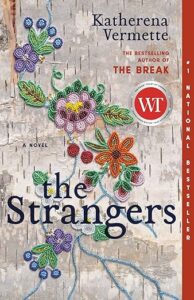
Setting: Winnipeg, Manitoba
FROM THE PUBLISHER: A breathtaking companion to her bestselling debut The Break, Vermette’s The Strangers brings readers into the dynamic world of the Stranger family, the strength of their bond, the shared pain in their past, and the light that beckons from the horizon. This is a searing exploration of race, class, inherited trauma, and matrilineal bonds that—despite everything—refuse to be broken.
Vermette’s second novel about the women of the Stranger family was a national bestseller, won the Atwood Gibson Writers’ Trust Prize for Fiction and was either shortlisted or longlisted for several other prizes including the 2021 Scotiabank Giller Prize and was named a Globe & Mail Best Book.
14. The Circle by katherena vermette
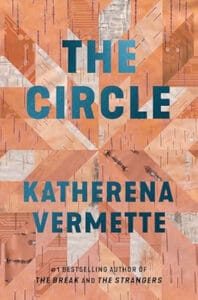
Setting: Winnipeg, Manitoba
FROM THE PUBLISHER: Fierce, heartbreaking, and profound, Vermette’s The Circle is the third and final companion novel to her bestsellers The Break and The Strangers. Told from various perspectives, with an unforgettable voice for each chapter, the novel is masterfully structured as a Restorative Justice Circle where all gather–both the victimized and the accused–to take account of a crime that has altered the course of their lives. It considers what it means to be abandoned by the very systems that claim to offer support, how it feels to gain a sense of belonging, and the unanticipated cost of protecting those you love most.
15. Bones of a Giant by Brian Thomas Isaac

Setting: The Okanagan, British Columbia
FROM THE PUBLISHER: From the award-winning, bestselling author of All the Quiet Places, comes Brian Thomas Isaac’s highly anticipated, haunting and tender return to the Okanagan Indian Reserve and a teenager’s struggle to become a man in a world of racism and hardship.
I recently purchased this novel only to discover that it’s a sequel to All the Quiet Places so now I’m waiting for that book to be delivered so I can read it first. The critically acclaimed All the Quiet Places won the 2022 Indigenous Voices Awards’ Published Prose in English Prize, was a Finalist for the 2022 Governor General’s Literary Award for Fiction and longlisted for the 2022 Scotiabank Giller Prize.
16. Indian Horse by Richard Wagamese

Setting: Northern Ontario
FROM THE PUBLISHER: Saul Indian Horse is a child when his family retreats into the woods. Among the lakes and the cedars, they attempt to reconnect with half-forgotten traditions and hide from the authorities who have been kidnapping Ojibway youth. But when winter approaches, Saul loses everything: his brother, his parents, his beloved grandmother—and then his home itself.
Winner of the Canada Reads People’s Choice award and the First Nations Communities Reads program and short-listed for the International IMPAC DUBLIN Literary Award. Named a Globe and Mail top 100 book of 2012 and a Best Novel of the Decade by Literary Hub.
17. Monkey Beach by Eden Robinson
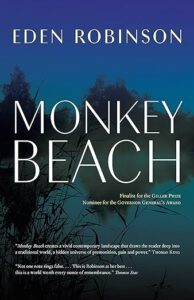
Setting: British Columbia
FROM THE PUBLISHER: Tragedy strikes a Native community when the Hill family’s handsome seventeen-year-old son, Jimmy, mysteriously vanishes at sea. Left behind to cope during the search-and-rescue effort is his sister, Lisamarie, a wayward teenager with a dark secret. She sets off alone in search of Jimmy through the Douglas Channel and heads for Monkey Beach—a shore famed for its sasquatch sightings.
Infused by turns with darkness and humour, Monkey Beach is a spellbinding voyage into the long, cool shadows of B.C.’s Coast Mountains, blending teen culture, Haisla lore, nature spirits and human tenderness into a multi-layered story of loss and redemption.
18. Truth Telling: Seven Conversations About Indigenous Life in Canada by Michelle Good
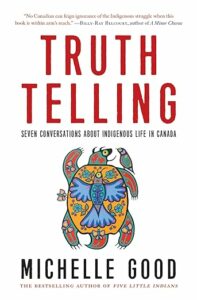
FROM THE PUBLISHER: From racism, broken treaties, and cultural pillaging, to the value of Indigenous lives and the importance of Indigenous literature, this collection reveals facts about Indigenous life in Canada that are both devastating and enlightening. Truth Telling also demonstrates the myths underlying Canadian history and the human cost of colonialism, showing how it continues to underpin modern social institutions in Canada.
A thought-provoking series of essays about the Indigenous experience in Canada and what is required for true reconciliation. Essential reading for all Canadians who want to honor the past and better understand the Indigenous experience and what is required to move forward.
19. The Inconvenient Indian by Thomas King
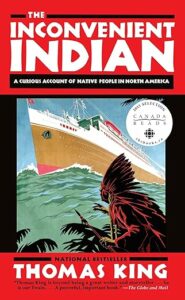
FROM THE PUBLISHER: In The Inconvenient Indian, Thomas King offers a deeply knowing, darkly funny, unabashedly opinionated, and utterly unconventional account of Indian–White relations in North America since initial contact. Suffused with wit, anger, perception, and wisdom, The Inconvenient Indian is at once an engaging chronicle and a devastating subversion of history, insightfully distilling what it means to be “Indian” in North America.
20. From the Ashes by Jesse Thistle
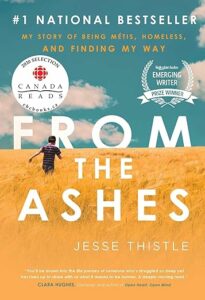
FROM THE PUBLISHER: In this extraordinary and inspiring debut memoir, Jesse Thistle, once a high school dropout and now a rising Indigenous scholar, chronicles his life on the streets and how he overcame trauma and addiction to discover the truth about who he is. Jesse writes honestly and fearlessly about his painful past, the abuse he endured, and how he uncovered the truth about his parents. Through sheer perseverance and education—and newfound love—he found his way back into the circle of his Indigenous culture and family.
An eloquent exploration of the impact of prejudice and racism, From the Ashes is, in the end, about how love and support can help us find happiness despite the odds.
21. 52 Ways to Reconcile: How to Walk with Indigenous Peoples on the Path to Healing by David A. Robertson
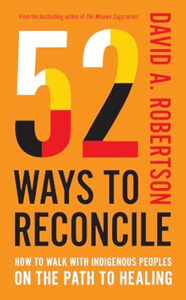
FROM THE PUBLISHER: 52 Ways to Reconcile is an accessible, friendly guide for non-Indigenous people eager to learn, or Indigenous people eager to do more in our collective effort towards reconciliation, as people, and as a country. As much as non-Indigenous people want to walk the path of reconciliation, they often aren’t quite sure what to do, and they’re afraid of making mistakes. This book is the answer and the long overdue guide.
The idea of this book is simple: 52 small acts of reconciliation to consider, one per week, for an entire year. They’re all doable, and they’re all meaningful. All 52 steps take readers in the right direction, towards a healthier relationship between Indigenous and non-Indigenous people and a time when we are past trauma. By following these steps, we can live in stronger and healthier communities equally, and respectfully, together.
I would love to hear any recommendations you have. Let me know in the comments below or reach out on social media.
Additional Reading
21 Must-Read Books Set in Canada
25 Books Set in Cold and Snowy Places to Read This Winter
10 of the Best Summer Vacations in Canada
52 Things To Do in Ontario: The Ultimate Ontario Bucket List
Pin This For Later
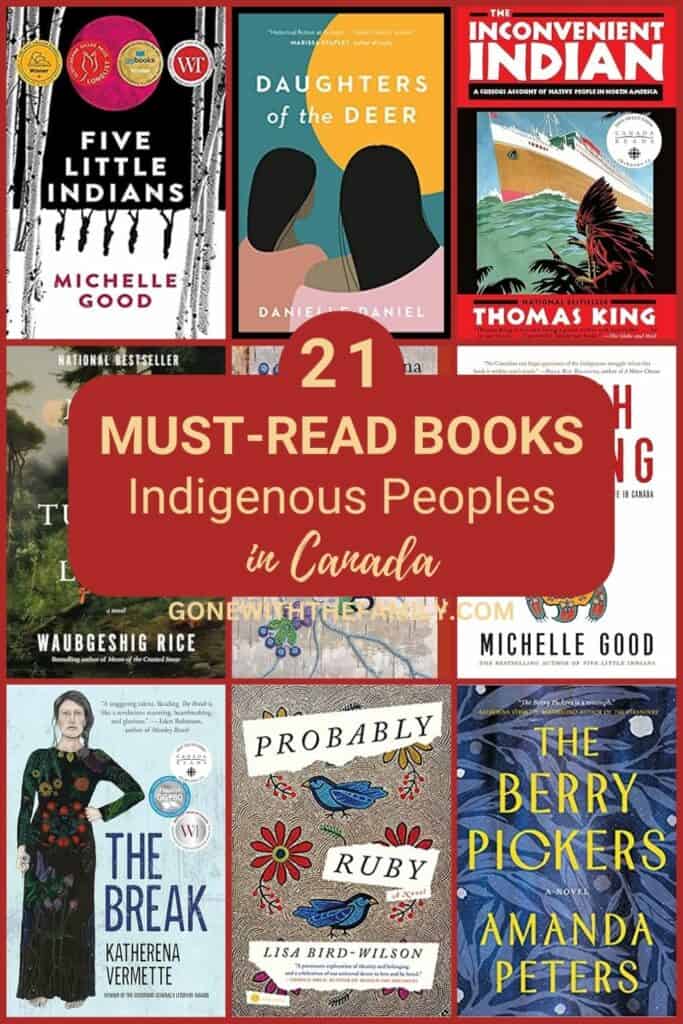

Leave a Reply